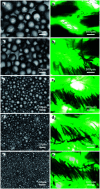Relation between the particle size and release characteristics of aromatic melamine microcapsules in functional textile applications
- PMID: 35528675
- PMCID: PMC9069868
- DOI: 10.1039/c9ra05196a
Relation between the particle size and release characteristics of aromatic melamine microcapsules in functional textile applications
Abstract
The relation between the particle size and release characteristics of aromatic microcapsules with a melamine resin shell in functional textile applications have been investigated. Firstly, the microcapsules are characterized based on their Fourier transform infrared spectra, encapsulation efficiencies, particle size distributions, optical images, and scanning electron microscopy images. The impregnation performances of the microcapsules have been initially evaluated using image analysis. Subsequently, the impregnation efficiency and broken release characteristics are semi-quantitatively analyzed using solid-phase microextraction-gas chromatography-mass spectrometry. The analysis results show that the highest impregnation efficiency and broken release intensity could be observed when the microcapsule size was similar to the fiber diameter (25-30 μm). Eventually, the sustained release of the microcapsules over a period of 2400 h was evaluated using the weighing calculation method, and the trends were studied using the Peppas model. It was found that the microcapsule release rate slowly and continuously decreased with time, and the release rates significantly increased with the decrease in microcapsule particle size. Thus, it could be concluded that the large microcapsules exhibited better leak tightness than the small microcapsules, whereas the small microcapsules exhibited faster sustained release rates.
This journal is © The Royal Society of Chemistry.
Conflict of interest statement
There are no conflicts to declare.
Figures









Similar articles
-
The Fabrication of Fragrance Microcapsules and Their Sustained and Broken Release Behavior.Materials (Basel). 2019 Jan 27;12(3):393. doi: 10.3390/ma12030393. Materials (Basel). 2019. PMID: 30691209 Free PMC article.
-
Fabrication and release behavior of nitrapyrin Microcapsules: Using modified melamine-formaldehyde resin as shell material.Sci Total Environ. 2020 Feb 20;704:135394. doi: 10.1016/j.scitotenv.2019.135394. Epub 2019 Nov 21. Sci Total Environ. 2020. PMID: 31796286
-
Preparation and Short-Term Aging Properties of Asphalt Modified by Novel Sustained-Release Microcapsules Containing Rejuvenator.Materials (Basel). 2019 Apr 4;12(7):1122. doi: 10.3390/ma12071122. Materials (Basel). 2019. PMID: 30987389 Free PMC article.
-
Preparation and Sustained-Release Performance of PLGA Microcapsule Carrier System.Nanomaterials (Basel). 2021 Jul 6;11(7):1758. doi: 10.3390/nano11071758. Nanomaterials (Basel). 2021. PMID: 34361144 Free PMC article.
-
Characterization of Polyallylamine/Polystyrene Sulfonate Polyelectrolyte Microcapsules Formed on Solid Cores: Morphology.Polymers (Basel). 2024 May 28;16(11):1521. doi: 10.3390/polym16111521. Polymers (Basel). 2024. PMID: 38891467 Free PMC article. Review.
Cited by
-
A Novel One-Step Reactive Extrusion Process for High-Performance Rigid Crosslinked PVC Composite Fabrication Using Triazine Crosslinking Agent@Melamine-Formaldehyde Microcapsules.Materials (Basel). 2023 Jun 26;16(13):4600. doi: 10.3390/ma16134600. Materials (Basel). 2023. PMID: 37444914 Free PMC article.
-
Design and application of polyurea microcapsules containing herbicide (oxyfluorfen).Des Monomers Polym. 2020 Sep 8;23(1):155-163. doi: 10.1080/15685551.2020.1816344. Des Monomers Polym. 2020. PMID: 33354157 Free PMC article.
-
Advancements in Assessments of Bio-Tissue Engineering and Viable Cell Delivery Matrices Using Bile Acid-Based Pharmacological Biotechnologies.Nanomaterials (Basel). 2021 Jul 19;11(7):1861. doi: 10.3390/nano11071861. Nanomaterials (Basel). 2021. PMID: 34361247 Free PMC article. Review.
-
Flavour encapsulation: A comparative analysis of relevant techniques, physiochemical characterisation, stability, and food applications.Front Nutr. 2023 Mar 2;10:1019211. doi: 10.3389/fnut.2023.1019211. eCollection 2023. Front Nutr. 2023. PMID: 36937359 Free PMC article. Review.
References
LinkOut - more resources
Full Text Sources

